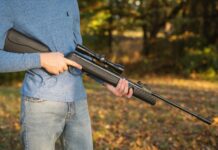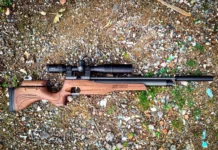You’re all brushed up on hunting lingo 101 and gun lingo 101, so let’s take it to the next level. Welcome to Hunting Slang 102.
Hunting slang is a less-than-official language that can vary by state or by region, but nonetheless, all hunters and their communities throw around terms and colloquialisms that you probably didn’t hear in your hunter safety course. Admittedly, some hunters are more crude in their slang, but they all have the same intention: to just have fun and make memories while embarking on one of the most natural journeys in the wild.
This list may not be comprehensive, but there’s plenty to add to your personal vernacular.
Game Slang:
Freezer Queen (synonyms: Old Long Nose, Slick Head, Baldy) — A female deer, typically big or old. These are worth shooting because they will fill up the freezer for plenty of dinners.
Speed Goat (synonym: Loper) — A pronghorn antelope, usually called just “antelope.” They are not actually part of the goat family, but they are the fastest. A pronghorn also isn’t technically an antelope, but they are distant relatives. A giraffe is a pronghorn antelope’s closest relative (who would’ve known?).
Dandy (synonyms: Toad, Shooter, Swamp Donkey, Pig) — A really nice male deer, typically big bodied or with a nice set of antlers and old or smart. You’ll be telling stories about this deer for a long time.
Button Buck (synonyms: Nub Buck, Nubby) — A young male deer with antlers that aren’t yet grown in. Their meat is usually tender and good eating, so depending on your goals as a hunter these could result in a successful hunt.
Mulies — Nickname for a mule deer which are typically found in the United States west of the Missouri River. They have a distinctly white behind, thick bodies, large tall ears similar to mule ears, and mature bucks have longer antler tines than whitetail deer.
Whiteys — Nickname for a whitetail deer, which are marked by their white fluffy fur on the bottom side of their tails. Whitetails can be found nearly anywhere in the U.S. except the Southwest, most of Alaska and Hawaii.
Huns — Nickname for Hungarian partridge, which are also known as gray partridge or English partridge, and have a mostly gray body and chest with some orange and cinnamon stripes throughout their feathering. They are a game bird weighing a little over a pound in the same family as pheasants and are typically found in the north central part of the U.S. Excellent eating if you can shoot one after it flushes, or flies, out of its hiding place.
Sharpies — Nickname for Sharptail Grouse
Spike — Any deer that has just one antler spike on both sides of their head, like two spikes (not to be confused with a unicorn, which only has one spike).
Fork Any deer that has antlers that branch out on either side of their head, resulting in a total of four points.
Gobbler (synonyms: Thunder Chicken, Boss Tom, Hammerhead, Red Head) — A male turkey, can be any of the types of turkeys like Merriams, Eastern, Rio Grande or Gould’s. The thundering and hammering referred to in the other nicknames come from the sound the male turkey makes during their mating dance, where they use their wings to beat the ground. They also make a sound like a gobble and the blood rushes to their head when they are excited, causing a red head.
Tree Rat — Quite simply—a squirrel! These can be either gray, red, black, or white, with white being very rare. Though they have a very fluffy long tail, they squeak, run and hide similar to rats.
Yote — A nickname for a coyote of any type, which are smaller than a wolf, but furry with a skinny snout and gray, brown, tan, white and black coloring. They can be found in nearly every state in the U.S. except Hawaii.
Dabblers — This term refers to waterfowl that eat by “dabbling” their heads underwater and keeping their butts above water. Types include the famous mallards, teal and wood ducks, as well as pintails and gadwalls. Coloring for each type ranges from grays to blacks, green, blue, brown and some orange tints.
Divers — Unlike dabblers that stay near the surface of the water, divers actually dive underwater to eat and find fish. These can include canvasbacks, scaup, Mergansers, and redheads.
Technical Slang:
BBD — Abbreviation for “Big Buck Down.” This phrase is used appropriately when a big buck has been shot and believed to be expired. A hunter would usually say this in extreme excitement.
Skunked — No, no real skunks involved here. If you have been hunting for quite a while and come home at the end of the day with no sign of your target animals or an opportunity to harvest, you’ve been “skunked” or unsuccessful.
Winded — It may be tempting to think “out of breath” on this one, but it actually means an animal smelled your scent through the wind, and basically implies you spooked them.
Busted — Similar to getting busted as a human caught red-handed, here an animal has spotted you in their natural territory, causing you to lose a decent opportunity.
Dirt Nap — One of my favorite slang phrases, this one refers to what happens when that animal goes down after a kill shot.
Flagging — Whitetail deer are known for doing this. If they are spooked or warning their fellow deer mates, their tail will perk up and the white undersides of their tails shake like a flag. This usually means you are close to blowing an opportunity to get closer or have already blown it.
Rattling — A fairly typical practice for deer or antlered animal hunting, this is when a hunter uses a pair of antler sheds or manufactured antlers to rattle together for attracting animals. Rattling imitates the sounds antlers make when two male antlered animals fight each other, typically during the rutting season or breeding season.
Bag — A bag is another word for a harvest limit, or however many animals you’re allotted to kill. Waterfowl and bird hunters usually use this term, and may or may not carry their game home in a bag.
Bagged Out or Tagged Out — This is when you’ve officially reached your harvest limit. The phrase “bagged out” is usually used in bird hunting while “tagged out” is usually used for four-legged animal hunting.
Buck Fever — Ah, yes. Good ol’ “buck fever.” Buck fever is a phenomenon that many enthusiastic hunters experience. When seeing a buck in the wild, especially one within the kill zone, a hunter may feel shaky knees, quickened heart rate, inconsistent breathing, sweaty palms, and frozen muscles. Adrenaline is to blame.
Smoke Pole — A nickname for a muzzleloader, a long-barreled gun that produces smoke when shot, due to the gunpowder that ignites when triggered.
Dope — No, not that kind of dope. Here we’re referring to urine of a female deer, or doe, that is in heat which is used in the hunt for a buck. It is found in the form of liquid within a bottle and can be sprayed or soaked on a wick, which can be hung on a tree limb. Place this in an effective spot and the scent will attract bucks during the rut.
The Rut — I’ve referenced this term a few times already, so I’ve saved the best for last. This is one of the ultimate times to hunt antlered deer. During this period of a hunting season, females are “in heat,” or preparing to be bred, and bucks are on the hunt to do the breeding. You interrupt the buck’s one-track-mindset and behavior during this period and voila, the perfect opportunity to harvest a beautiful buck is upon you.











































